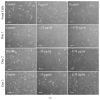Time controlled release of arabinofuranosylcytosine (Ara-C) from agarose hydrogels using layer-by-layer assembly: an in vitro study
- PMID: 21294967
- PMCID: PMC3873741
- DOI: 10.1163/092050610X552221
Time controlled release of arabinofuranosylcytosine (Ara-C) from agarose hydrogels using layer-by-layer assembly: an in vitro study
Abstract
Experimentally induced axonal regeneration is compromised by glial scar formation arising from leptomeningeal fibroblasts cells in and around the hydrogel scaffold implanted for nerve repair. Strategies are needed to prevent such fibroblastic reactive cell layer formation for enhanced axonal regeneration. Here, we implement the technique of layer-by-layer assembled degradable, hydrogen bonded multilayers on agarose hydrogels to incorporate an anti-mitotic drug (1-β-D-arabinofuranosylcytosine (Ara-C)) within the agarose hydrogels. We show controlled release of Ara-C under physiological conditions over a period of days. The concentrations of Ara-C released from agarose at the different time points were sufficient to inhibit fibroblast growth in vitro, while not adversely affecting the viability of the neuronal cells.
Figures
















Similar articles
-
Agarose hydrogels embedded with pH-responsive diblock copolymer micelles for triggered release of substances.Biomacromolecules. 2013 Aug 12;14(8):2713-23. doi: 10.1021/bm4005639. Epub 2013 Jul 12. Biomacromolecules. 2013. PMID: 23815070 Free PMC article.
-
Xylan-based temperature/pH sensitive hydrogels for drug controlled release.Carbohydr Polym. 2016 Oct 20;151:189-197. doi: 10.1016/j.carbpol.2016.05.075. Epub 2016 May 24. Carbohydr Polym. 2016. PMID: 27474557
-
Enhancing the efficacy of Ara-C through conjugation with PAMAM dendrimer and linear PEG: a comparative study.Biomacromolecules. 2013 Mar 11;14(3):801-10. doi: 10.1021/bm3018615. Epub 2013 Feb 19. Biomacromolecules. 2013. PMID: 23373724
-
Engineered hydrogen-bonded polymer multilayers: from assembly to biomedical applications.Chem Soc Rev. 2011 Jan;40(1):19-29. doi: 10.1039/c0cs00001a. Epub 2010 Sep 30. Chem Soc Rev. 2011. PMID: 20882254 Review.
-
Polyethylene glycol (PEG)-Poly(N-isopropylacrylamide) (PNIPAAm) based thermosensitive injectable hydrogels for biomedical applications.Eur J Pharm Biopharm. 2014 Nov;88(3):575-85. doi: 10.1016/j.ejpb.2014.07.005. Epub 2014 Aug 1. Eur J Pharm Biopharm. 2014. PMID: 25092423 Review.
Cited by
-
Construction of a Novel Magnetic Targeting Anti-Tumor Drug Delivery System: Cytosine Arabinoside-Loaded Bacterial Magnetosome.Materials (Basel). 2013 Sep 3;6(9):3755-3763. doi: 10.3390/ma6093755. Materials (Basel). 2013. PMID: 28788304 Free PMC article.
-
Comparison of cellular architecture, axonal growth, and blood vessel formation through cell-loaded polymer scaffolds in the transected rat spinal cord.Tissue Eng Part A. 2014 Nov;20(21-22):2985-97. doi: 10.1089/ten.TEA.2013.0551. Epub 2014 Aug 11. Tissue Eng Part A. 2014. PMID: 24854680 Free PMC article.
-
The Impact of Prestretch Induced Surface Anisotropy on Axon Regeneration.Tissue Eng Part C Methods. 2016 Feb;22(2):102-112. doi: 10.1089/ten.TEC.2015.0328. Epub 2016 Jan 8. Tissue Eng Part C Methods. 2016. PMID: 26563431 Free PMC article.
-
Augmenting protein release from layer-by-layer functionalized agarose hydrogels.Carbohydr Polym. 2014 Mar 15;103:377-84. doi: 10.1016/j.carbpol.2013.12.069. Epub 2013 Dec 28. Carbohydr Polym. 2014. PMID: 24528743 Free PMC article.
-
Bioprocessing strategies to enhance the challenging isolation of neuro-regenerative cells from olfactory mucosa.Sci Rep. 2018 Sep 27;8(1):14440. doi: 10.1038/s41598-018-32748-w. Sci Rep. 2018. PMID: 30262897 Free PMC article.
References
Publication types
MeSH terms
Substances
Grants and funding
LinkOut - more resources
Full Text Sources
Other Literature Sources
